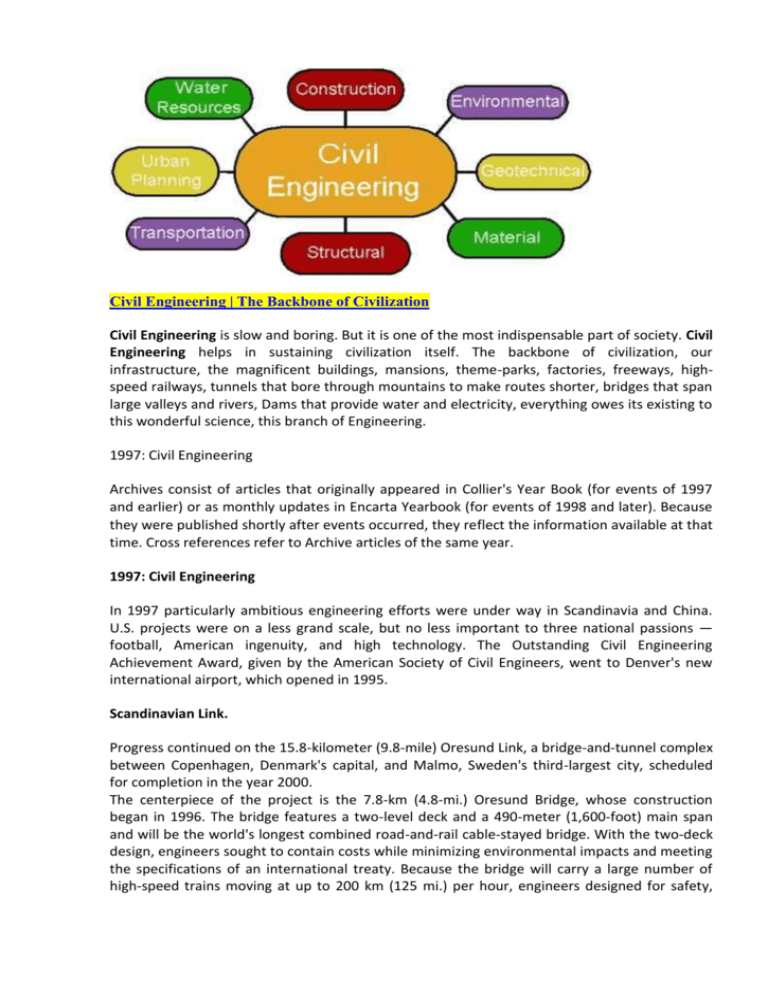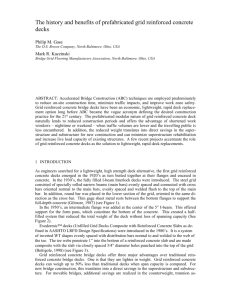
Civil Engineering | The Backbone of Civilization
Civil Engineering is slow and boring. But it is one of the most indispensable part of society. Civil
Engineering helps in sustaining civilization itself. The backbone of civilization, our
infrastructure, the magnificent buildings, mansions, theme-parks, factories, freeways, highspeed railways, tunnels that bore through mountains to make routes shorter, bridges that span
large valleys and rivers, Dams that provide water and electricity, everything owes its existing to
this wonderful science, this branch of Engineering.
1997: Civil Engineering
Archives consist of articles that originally appeared in Collier's Year Book (for events of 1997
and earlier) or as monthly updates in Encarta Yearbook (for events of 1998 and later). Because
they were published shortly after events occurred, they reflect the information available at that
time. Cross references refer to Archive articles of the same year.
1997: Civil Engineering
In 1997 particularly ambitious engineering efforts were under way in Scandinavia and China.
U.S. projects were on a less grand scale, but no less important to three national passions —
football, American ingenuity, and high technology. The Outstanding Civil Engineering
Achievement Award, given by the American Society of Civil Engineers, went to Denver's new
international airport, which opened in 1995.
Scandinavian Link.
Progress continued on the 15.8-kilometer (9.8-mile) Oresund Link, a bridge-and-tunnel complex
between Copenhagen, Denmark's capital, and Malmo, Sweden's third-largest city, scheduled
for completion in the year 2000.
The centerpiece of the project is the 7.8-km (4.8-mi.) Oresund Bridge, whose construction
began in 1996. The bridge features a two-level deck and a 490-meter (1,600-foot) main span
and will be the world's longest combined road-and-rail cable-stayed bridge. With the two-deck
design, engineers sought to contain costs while minimizing environmental impacts and meeting
the specifications of an international treaty. Because the bridge will carry a large number of
high-speed trains moving at up to 200 km (125 mi.) per hour, engineers designed for safety,
taking into account the anticipated fatigue of materials during the 100-year design life of the
structure.
A major connecting road to the Oresund Link was completed in 1997 with the opening of a 9km (5.6-mi.) four-lane highway from Copenhagen Airport to the Oresund coast.
Huge Chinese Dam.
Work continued apace on China's massive Three Gorges Dam. The project on the notoriously
fierce Yangtze, the world's third-largest river, is scheduled for completion in 2009. In China,
1997 was called the Year of Double Happiness, because Great Britain ceded Hong Kong back to
the Chinese and because the end of the first phase of the Three Gorges project was reached,
with a cofferdam extending all the way across the Yangtze.
China, the world's fastest-growing economy, is a country choking on the fumes from burning
coal. The Three Gorges Dam will produce over 18,000 megawatts of clean electricity (enough to
supply 10 percent of China's total consumption), feeding major cities such as Wuhan, Nanjing,
and Shanghai, among others. It also will make the Yangtze navigable by large vessels for more
than 2,400 km (1,500 mi.) inland — all the way to Chongqing — and will displace 1 to 2 million
people, for whom the Chinese government has promised to build new settlements (on less-rich
agricultural land). The dam will stretch more than 2 km. (1.2 mi.) across the Yangtze and rise
185 meters (607 feet).
The project has come under harsh criticism from environmentalists around the world. Critics
contend that the dam may destroy commercial fish stocks, deprive floodplain agricultural
systems of needed water and silt, and pour silt into the harbor at the river port of Chongqing,
thereby threatening the livelihoods of 75 million people who live along the Yangtze's banks.
Some experts say promised flood-control benefits are unsubstantiated, and the project might
actually increase the number of people at risk of flooding.
New Stadium for DC Team.
Jack Kent Cooke Stadium, the new home of the National Football League's Washington
Redskins, was completed at record speed, in time for the 1997 season opener. It took the
construction team less than 18 months, as opposed to the 26 months normally required for
sports facilities of this magnitude. Designed by HOK Sports Facilities Group of Kansas City, MO,
the stadium is located in Landover, MD, at a site that Cooke named Raljon for his sons, Ralph
(who died in 1995) and John. It includes seating for 78,600 people and features over 200 luxury
skyboxes and more than 15,000 club-level seats.
One of the ways the Clark Construction Group crew was able to keep to the tight schedule was
by using two systems of "formwork" simultaneously: traditional formwork (temporary wooden
"boxes" into which wet concrete is poured to set) and 32,000-pound (14,500-kilogram) form
"tables" on casters. While concrete placed using the rollable form tables was setting, traditional
formwork was used to place other sections of concrete in areas such as the corners of the
stadium.
Construction crews had to battle groundwater. When they started digging the basement, twothirds of the footprint was at one elevation and one-third was 20 feet (6 meters) farther down.
At the lower elevation, the construction team ran into a vast amount of perched water (pockets
of groundwater) that had not been present when borings were taken in 1995. Crews solved the
problem by digging a network of French, or rubble, drains (gravel-filled trenches) to pump out
the water.
In addition, an old landfill was encountered; it radiated from the site's center in the shape of a
pie slice, roughly from the one o'clock to the three o'clock position. Construction was begun at
the three o'clock position, and, working clockwise, crews simultaneously excavated all the
contaminated material and replaced it with fill from the part of the site they were actively
building. In all, 1.8 million cubic yards (1.4 million cubic meters) were excavated.
Composite Bridges.
The first two short-span, modular, fiber-reinforced polymer (FRP) vehicle-bridge decks in the
United States, the Laurel Lick and the Wickwire Run, were installed in West Virginia in spring
1997, replacing existing bridges that were old timber structures.
The bridge replacement was a collaborative effort. West Virginia University developed the
concept of modular bridges and conducted the research needed to build them. The West
Virginia Department of Transportation handled the engineering and design of the structures.
And Creative Pultrusions, Inc., of Alum Bank, PA, manufactured the bridge decks and the
superstructure for the Wickwire Run bridge.
The FRP composite materials used to create the decks are noncorrosive, have a high stiffnessto-weight ratio, and are extremely light, easing installation. The structures' light weight reduces
the need for labor hours and heavy equipment. It took only five and a half hours to install each
bridge deck. The FRP decks and the glass-fiber structures were manufactured using pultrusion
(an automated process for manufacturing shaped composite materials with a constant volume),
creating what is called an H deck.
A laboratory test involving accelerated aging indicated that the glass-fiber structure is durable
enough to meet the American Association of State Highway and Transportation Officials'
standards — strong enough, in fact, to last 40 to 50 years before needing repair.
The Laurel Lick's deck, supported by pultruded composite beams, is 20 ft. (6 m) long and 16 ft.
wide, while the Wickwire Run's deck, on steel beams, is 30 ft. (9 m) long and 21.5 ft. wide. The
total cost of the Laurel Lick span was $72,000; the Wickwire Run bridge deck cost about
$50,000. West Virginia University expected the cost of FRP bridges to drop as increased
demand made possible the mass production of modules.
In July an all-composites vehicle bridge was installed on a county road over a creek in Butler
County, OH. It took only three hours to put the FRP modular bridge deck and beam structure
between the abutments. The bridge is 33 ft. (10 m) long and 24 ft. wide, and with its beams
weighs less than 10 metric tons — about a fifth of what a reinforced concrete bridge would
weigh.
Microsoft ® Encarta ® Encyclopedia 2004. © 1993-2003 Microsoft Corporation. All rights
reserved.











